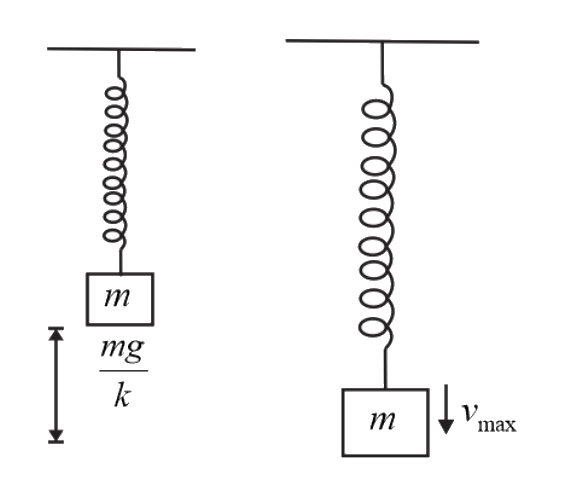A particle suspended from a vertical spring oscillates 8 times per second. At the highest point of oscillation the spring becomes unstretched. The maximum speed of the block will be
10 cm/s
20 cm/s
30 cm/s
40 cm/s
The correct Answer is:B
To find the maximum speed of the block suspended from a vertical spring oscillating at a frequency of 8 Hz, we can follow these steps:
Step 1: Identify the frequency and calculate angular frequency (ω)
The frequency (f) of the oscillation is given as 8 Hz. The angular frequency (ω) can be calculated using the formula:
ω=2πf
Substituting the value of f:
ω=2π×8=16π rad/s
Step 2: Determine the amplitude (A)
At the highest point of oscillation, the spring becomes unstretched. The maximum stretch (or amplitude, A) of the spring is when the weight of the block (mg) is balanced by the spring force (kx). Thus, we can express the amplitude as:
A=mgk
Where:
- m = mass of the block
- g = acceleration due to gravity (approximately 9.81 m/s²)
- k = spring constant
Step 3: Relate angular frequency to spring constant and mass
The angular frequency (ω) is also related to the spring constant (k) and mass (m) by the formula:
ω=√km
Squaring both sides gives:
ω2=km
From this, we can express k as:
k=mω2
Step 4: Substitute k in the amplitude equation
Substituting the expression for k into the amplitude equation:
A=mgmω2=gω2
Step 5: Calculate maximum speed (Vmax)
The maximum speed (Vmax) in simple harmonic motion is given by:
Vmax=ωA
Substituting the expression for A:
Vmax=ω(gω2)=gω
Step 6: Substitute known values
Now substituting the values of g and ω:
Vmax=9.8116π
Calculating this gives:
Vmax≈9.8150.27≈0.195m/s
Step 7: Convert to cm/s
To convert the maximum speed from meters per second to centimeters per second:
Vmax≈0.195×100=19.5 cm/s≈20 cm/s
Conclusion
The maximum speed of the block is approximately 20 cm/s.
---
The frequency (f) of the oscillation is given as 8 Hz. The angular frequency (ω) can be calculated using the formula:
ω=2πf
Substituting the value of f:
ω=2π×8=16π rad/s
At the highest point of oscillation, the spring becomes unstretched. The maximum stretch (or amplitude, A) of the spring is when the weight of the block (mg) is balanced by the spring force (kx). Thus, we can express the amplitude as:
A=mgk
Where:
- m = mass of the block
- g = acceleration due to gravity (approximately 9.81 m/s²)
- k = spring constant
The angular frequency (ω) is also related to the spring constant (k) and mass (m) by the formula:
ω=√km
Squaring both sides gives:
ω2=km
From this, we can express k as:
k=mω2
Substituting the expression for k into the amplitude equation:
A=mgmω2=gω2
The maximum speed (Vmax) in simple harmonic motion is given by:
Vmax=ωA
Substituting the expression for A:
Vmax=ω(gω2)=gω
Now substituting the values of g and ω:
Vmax=9.8116π
Calculating this gives:
Vmax≈9.8150.27≈0.195m/s
To convert the maximum speed from meters per second to centimeters per second:
Vmax≈0.195×100=19.5 cm/s≈20 cm/s
The maximum speed of the block is approximately 20 cm/s.
Topper's Solved these Questions
- BOOK - NARAYNACHAPTER - OSCILLATIONSEXERCISE - EVALUATE YOURSELF - 35videos
OSCILLATIONS
- BOOK - NARAYNACHAPTER - OSCILLATIONSEXERCISE - EVALUATE YOURSELF - 48videos
OSCILLATIONS
- BOOK - NARAYNACHAPTER - OSCILLATIONSEXERCISE - EVALUATE YOURSELF - 17videos
OSCILLATIONS
- BOOK - NARAYNACHAPTER - NEWTONS LAWS OF MOTIONEXERCISE - PASSAGE TYPE QUESTION6videos
NEWTONS LAWS OF MOTION
- BOOK - NARAYNACHAPTER - PHYSICAL WORLDEXERCISE - C.U.Q10videos
PHYSICAL WORLD
Similar Questions
A particle suspended from a vetical spring oscillastes 10 times per sencon. At the highest point of oscillation the spring becomes unstretched. A. Find the maximum speed of the block. B. Find the speed when the spring is stretche by 0.20 cm. Take g=π2ms−2
View SolutionA particle suspended from a vertical spring oscillates 10 times per second. At the highest point of oscillation , the spring becomes upstretched . Find the speed when the spring is stretched by 0.20 cm . (Take , g=π2m/s2)
 View Solution
View Solution
Knowledge Check
- Question 1 - Select One
Frequency of a particle executing SHM is 10 Hz. The particle is suspended from a vertical spring. At the highest point of its oscillation the spring is unstretched. Maximum speed of the particle is (g=10m/s2
A2πm/sBπm/sC1πm/sD12πm/s - Question 2 - Select One
Frequency of a particle executing SHM is 10 Hz. The particle is suspended from a vertical spring. At the highest point of its oscillation the spring is unstretched. Maximum speed of the particle is (g=10ms)
A2πmsBπmsC1πmsD12π/ms - Question 3 - Select One
A mass suspended on a vertical spring oscillates with a period of 0.5s. When the mass is allowed to hang at rest, the spring is stretched by
A3.1cmB6.2cmC9.3cmD12.4cm
Frequency of a particle executing SHM is 10Hz. The particle is suspended form a vertical spring. At the highest point of its oscillation the spring is unstretched. Find the maximum speed of the particle: (g=10m/s2)
View SolutionOscillations of a mass suspended from a vertical spring is ……………………………motion.
View SolutionA block weighing 10N is attached to the lower end of a vertical spring (k =200N/m), the other end of which is attached to a ceiling. The block oscillates vertically and has a kinetic energy of 2.0J as it passes through the point at which the spring is unstretched. The amplitude of the oscillation of block is
View SolutionA mass is suspended from a vertica spring which is executing SHM of frequency 5 Hz.
The spring is unstretched at the highest point of oscillation. Maximum speed of the mass is (take, acceleration due to gravity, g=10m/s2 )View SolutionA body of mass 1kg suspended an ideal spring oscillates up and down. The amplitude of oscillation is 1 metre and the periodic time is 1.57 second. Determine.
View Solution

